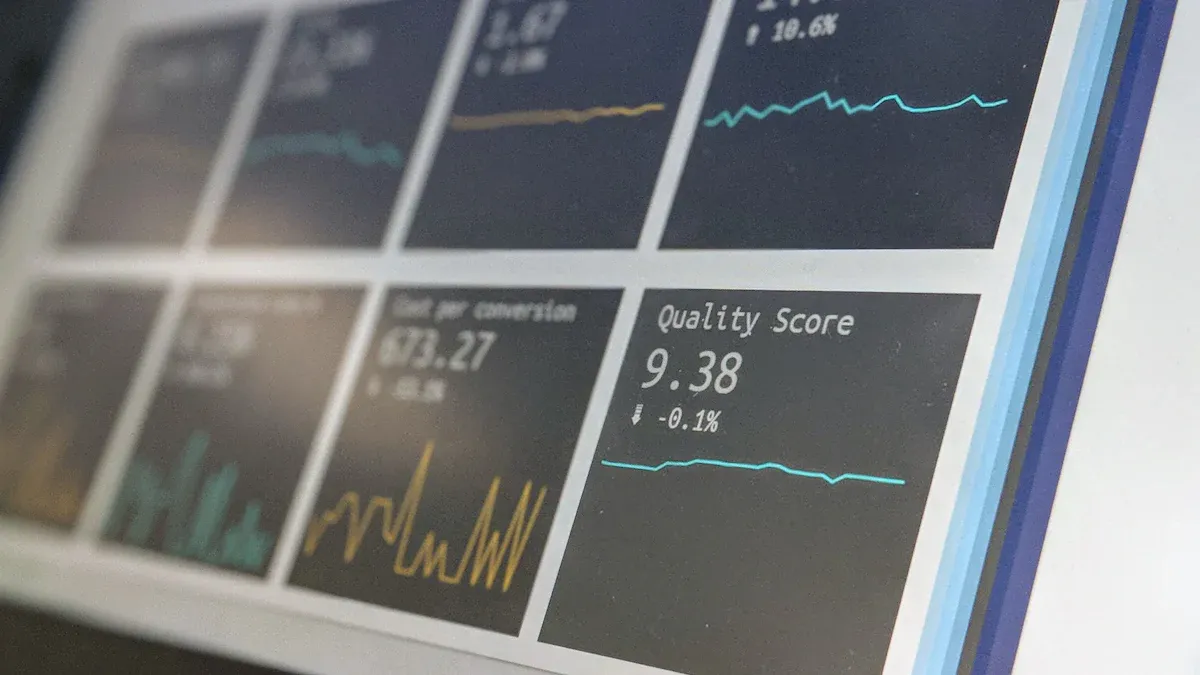- EasyCard
- Trade
- Help
- Announcement
- Academy
- SWIFT Code
- Iban Number
- Referral
- Customer Service
- Blog
- Creator
How to Understand EBITA for Your Startup’s Success in 2025

Image Source: unsplash
If you want your startup to stand out in 2025, you need to understand ebita. Imagine you are meeting with investors or lenders who want proof that your business can thrive. When you understand ebita, you give potential investors a clear view of how your business works, without confusion from taxes or debt. This helps you show your business success and attract more investors. A strong grasp of ebita lets you explain your business in a way that builds trust and shows your business can grow.
Key Takeaways
- EBITA shows your startup’s earnings from core business activities by excluding interest, taxes, and amortization, giving a clear view of operational profitability.
- Investors use EBITDA to compare startups, judge financial health, and decide on funding, making it a key metric to attract investment.
- Calculate EBITDA by adding back interest, taxes, depreciation, and amortization to net income to focus on your business’s true operational performance.
- Track EBITDA trends to spot strengths and weaknesses in your startup, but always use it with other financial metrics like cash flow for a complete picture.
- Avoid common mistakes like confusing EBITDA with cash flow or ignoring one-time costs to ensure accurate financial reporting and build investor trust.
Understand EBITA for Startups
What Is EBITA?
You need to understand ebita if you want to measure how well your startup runs its core business. EBITA stands for Earnings Before Interest, Taxes, and Amortization. You start with EBIT, which is your earnings before interest and taxes, and then add back amortization expenses. You can also calculate it from net income by adding back interest, taxes, and amortization. This method removes the effects of financing costs, tax expenses, and the amortization of intangible assets. When you use ebita, you focus on your company’s ability to earn income from its main activities. This gives you a clear view of operational profitability.
Tip: EBITA helps you see how much income your business generates from daily operations, without the noise of taxes or debt payments.
Why It Matters
EBITDA plays a big role in showing investors how your startup performs. Financial experts say that EBITDA isolates earnings from your core business activities. It leaves out interest, taxes, depreciation, and amortization. This gives you and your investors a clear snapshot of operational profitability. When you present EBITDA, you help investors see how your business generates revenue and manages expenses. This metric appears in financial statements, startup valuation, investor communications, and strategic planning. You can also use it to compare your business to others in your industry.
- EBITDA is simple and easy to understand.
- It focuses on your business operations, not outside factors.
- Investors use it to compare startups and make funding decisions.
- It helps you track your performance over time.
A higher EBITDA signals better operational profitability. This makes your startup more attractive to investors. They use EBITDA to judge your economic viability. They want to know how you generate revenue, manage costs, and plan for growth. When you understand ebita, you can show potential investors that your business has a strong foundation. This builds trust and helps you secure funding.
Venture capitalists look at your income statement, which includes EBITDA, to analyze your business model and valuation. They use EBITDA to compare your startup to others and to set funding terms. If you have strong EBITDA figures, you may get better funding offers and higher valuations. You also build trust by sharing clear and honest EBITDA numbers.
Financial Health
EBITDA gives you a way to check your startup’s financial health. For early-stage startups, you may focus more on market potential and user growth. As your business grows, you need to show real financial results. Late-stage startups use metrics like revenue, EBITDA, cash flow, and profitability to prove their value. EBITDA adapts to your business stage and helps you measure operational efficiency.
When you use EBITDA, you focus on income from your main business. You leave out interest, taxes, depreciation, and amortization. This makes it easier to compare your business to others, even if they have different capital structures or accounting rules. EBITDA acts as a proxy for cash flow and helps you forecast future performance. You can use it to plan for growth and to show investors your progress.
Note: EBITDA does not include capital expenditures or changes in working capital. If you only look at EBITDA, you might overestimate your available cash flow. Always use EBITDA with other financial metrics, like net income and operating cash flow, for a complete picture.
| Metric | Focus Area | Best For |
|---|---|---|
| EBITDA | Operational performance | Comparing startups |
| Net Income | Total profitability | Tax and dividend plans |
| Cash Flow | Liquidity and spending | Planning investments |
When you understand ebita, you gain a powerful tool for business valuations and startup valuation. You can track your income, revenue, and financial performance as your business grows. This helps you make smart decisions and show investors that your business is ready for success.
Calculate EBITDA Step by Step

Image Source: pexels
EBITDA Formula
You can calculate EBITDA using a simple formula. Start with your net income, then add back interest, taxes, depreciation, and amortization. The formula looks like this:
EBITDA = Net Income + Interest Expense + Taxes + Depreciation + Amortization
Net income shows your total earnings after all expenses. Interest expense is the cost your business pays to lenders. Taxes are what you owe to the government. Depreciation is a non-cash expense that tracks the loss in value of your equipment or other tangible assets. Amortization is a non-cash expense for intangible assets, such as software or patents. This formula helps you focus on your business’s core financial performance, removing the effects of financing and accounting choices.
Tip: You can also calculate EBITDA by starting with operating profit and adding back depreciation and amortization.
Key Components
When you calculate EBITDA, you need to understand each part:
- Net income: Your business’s total profit after all costs.
- Interest: Extra money paid to lenders, not part of daily operations.
- Taxes: Payments to local, state, or federal governments.
- Depreciation: The gradual loss in value of things like equipment.
- Amortization: The slow decrease in value of things like software or trademarks.
These components help you see your business’s operational profitability. EBITDA lets you compare your business to others, even if they use different accounting methods or have different capital structures. This makes it easier for investors to judge your financial health and business success.
Example for Startups
Here is a practical example for a technology startup. This table shows how to calculate EBITDA step by step:
| Financial Item | Amount (USD) |
|---|---|
| Net Income | 100,000 |
| Interest Expenses | 10,000 |
| Tax Expenses | 15,000 |
| Depreciation | 5,000 |
| Amortization | 2,000 |
| EBITDA (Sum) | 132,000 |
You start with net income and add back interest, taxes, depreciation, and amortization. This gives you an EBITDA of $132,000. This number shows your business’s operational profitability and helps you track financial performance.
Note: Many startups make mistakes when they calculate EBITDA. Some forget to add back amortization, while others double-count expenses. Always check your numbers to avoid errors and give investors a clear view of your business.
Interpreting EBITDA Results

Image Source: unsplash
High vs. Low EBITDA
When you look at your EBITDA, you see how well your startup manages income from its main activities. Investors and lenders use EBITDA multiples to judge if your business is undervalued or overvalued. A high EBITDA margin shows strong earnings and good cost control. This makes your startup more attractive to investors. A low EBITDA margin can signal problems with profitability or cash flow. Investors often compare EBITDA margins between startups and mature companies to find the best investment.
- Investors use EBITDA multiples to spot good acquisition targets.
- A low EBITDA multiple may mean your business is a good buy.
- High EBITDA margins show stable income and efficient management.
- Low margins can mean your business faces financial challenges.
You should remember that EBITDA does not include debt, capital expenditures, or changes in working capital. Always look at EBITDA with other financial metrics to get a full picture of your business’s financial performance.
| Stage | EBITDA Multiple (Forward Looking) | EBITDA Multiple (Trailing) |
|---|---|---|
| Early-stage startup | 8 - 10x | 10 - 12x |
Early-stage startups often have lower or less reliable EBITDA multiples. Growth-stage startups, with more predictable revenue and positive EBITDA, can use these multiples for startup valuation.
Trends and Decisions
Tracking EBITDA trends helps you understand your business’s operational strengths and weaknesses. When you see EBITDA grow year over year, you know your operational profitability is improving. If EBITDA falls, you may need to check your expenses or income sources. You should also compare your EBITDA to industry averages. This helps you see how your business stands against competitors.
- Monitor EBITDA growth to track improvements in operational profitability.
- Keep operational expenses low to maintain healthy EBITDA margins.
- Use EBITDA in investor communications and strategic planning.
- Benchmark against industry averages to check your competitive position.
- Evaluate how well your business turns revenue into income.
An increasing EBITDA or stable multiples show strong management and efficient operations. Declining EBITDA or lower multiples may reveal challenges that need attention.
Common Mistakes
Many founders make mistakes when they use EBITDA. If you ignore non-recurring costs, you might inflate EBITDA and get a false sense of ongoing profitability. Overlooking depreciation and amortization can also give you an inaccurate view of financial performance. Some people confuse EBITDA with cash flow, which can lead to poor decisions about spending or growth.
Tip: Always remember that EBITDA does not show true cash flow or debt-servicing ability. High EBITDA does not always mean your business can generate cash or pay its debts.
Here are some common mistakes to avoid:
- Ignoring one-time costs, which can make EBITDA look better than it is.
- Forgetting depreciation and amortization, which hides real expenses.
- Treating EBITDA as cash flow, which can cause liquidity problems.
- Thinking high EBITDA means strong financial health, without checking debt or cash flow.
If you rely only on EBITDA, you might overestimate your business’s stability. Always use other financial metrics to support your decisions and show potential investors the real picture.
EBITDA vs. Other Metrics
EBITDA vs. Revenue
You often hear about ebitda vs. revenue when you look at startup financial performance. Revenue shows the total income your business brings in from sales before any expenses. It acts as a top-line indicator of your sales activity and market demand. In contrast, ebitda measures operational profitability by subtracting operating expenses (except interest, taxes, depreciation, and amortization) from revenue. This gives you a clearer picture of how efficiently your startup turns sales into profit.
- Revenue is important for early-stage startups to show growth and attract potential investors.
- EBITDA becomes more useful as your business matures and you want to highlight operational efficiency.
- Revenue does not show how much it costs to generate sales, while ebitda reveals how well you manage costs and generate cash from your core business.
- EBITDA margin helps you compare your operational profitability with other companies, even if they have different debt or tax situations.
Note: EBITDA does not represent actual net earnings. It leaves out important costs, so you should not use it alone to judge business success.
When to Use Each
You should use revenue to track sales momentum and market traction, especially in the early stages of your startup. Investors and lenders often look at revenue multiples for startup valuation when profits are low or negative. As your business grows and starts to generate cash, ebitda becomes more relevant. You can use ebitda to show operational profitability and efficiency, which is important for business valuations and attracting investors.
A table can help you decide which metric to focus on:
| Stage | Focus Metric | Why Use It |
|---|---|---|
| Early-stage | Revenue | Shows sales growth and market demand |
| Growth-stage | EBITDA, EBITDA margin | Highlights operational profitability and efficiency |
Tip: Both ebitda and revenue together give you a full view of financial performance. Use revenue to show growth and ebitda to show how well you turn that growth into profit.
Limitations
EBITDA has some important limits. It does not account for capital expenditures, which are key for startup growth. It ignores non-cash items like depreciation and amortization, which can affect true profitability. EBITDA margin can vary a lot between industries, so comparing across sectors may mislead you. The metric also does not reflect changes in working capital, which impacts cash flow and liquidity.
- EBITDA may overstate short-term cash flow by ignoring reinvestment needs.
- It does not show the impact of debt or interest expenses, which can be high for some startups.
- Revenue does not show if your business is profitable, while ebitda can miss important costs.
Financial analysts recommend you use ebitda with other metrics like free cash flow and net income. This approach gives you a more complete picture of your startup’s financial health and helps you make better decisions for business success.
Understanding EBITA gives you a clear view of your startup’s operational profitability and helps you attract investors. Regularly tracking EBITDA supports better decisions about resource allocation and growth. Many successful startups use EBITDA in business planning, investor updates, and performance benchmarking. Start by building detailed income statements and reviewing key financial metrics. Financial literacy empowers you to manage your business, improve profitability, and increase your chances of business success.
FAQ
What is the main difference between EBITDA and EBITA?
You calculate EBITDA by adding back depreciation and amortization to earnings before interest and taxes. EBITA only adds back amortization. EBITDA gives you a broader view of operational profitability. Both help you understand your business performance and attract investors.
Why do investors care about EBITDA margin?
Investors and lenders use EBITDA margin to see how well your startup controls costs and generates cash from operations. A strong margin shows good profitability and financial health. This can improve your startup valuation and help you secure funding for business success.
How does EBITDA help with startup valuation?
EBITDA helps you show potential investors your business’s ability to generate income from core activities. Many use EBITDA multiples to compare startups and set valuation. This makes it easier to benchmark your financial performance and plan for growth.
Can EBITDA replace cash flow for business decisions?
No, you should not use EBITDA alone to make business decisions. EBITDA does not include capital expenditures or changes in working capital. Always check cash flow and other financial metrics to get a full picture of your business’s financial health and performance.
Understanding EBITA helps startups showcase operational profitability, with a $132,000 EBITA reflecting strong core performance in our example. To optimize financial management in 2025, consider BiyaPay. BiyaPay offers transfer fees as low as 0.5%, significantly lower than traditional bank fees ($20-$50), with real-time exchange rate transparency across 30+ fiat currencies and 200+ cryptocurrencies in 100+ countries. Its Biya EasyCard, a virtual payment card with no annual fee, supports platforms like eBay and PayPal, ideal for online subscriptions or global purchases. Whether funding operations, paying suppliers, or managing expenses, BiyaPay ensures same-day transfers and quick registration with simple ID verification. Secured by U.S. and New Zealand financial licenses, it guarantees safe, reliable transactions. Unlike high-cost bank transfers, BiyaPay maximizes your startup’s cash flow for growth or investor pitches. Sign up at BiyaPay to streamline global payments, enhance financial efficiency, and boost your startup’s success in 2025!
*This article is provided for general information purposes and does not constitute legal, tax or other professional advice from BiyaPay or its subsidiaries and its affiliates, and it is not intended as a substitute for obtaining advice from a financial advisor or any other professional.
We make no representations, warranties or warranties, express or implied, as to the accuracy, completeness or timeliness of the contents of this publication.




Contact Us
Company and Team
BiyaPay Products
Customer Services
is a broker-dealer registered with the U.S. Securities and Exchange Commission (SEC) (No.: 802-127417), member of the Financial Industry Regulatory Authority (FINRA) (CRD: 325027), member of the Securities Investor Protection Corporation (SIPC), and regulated by FINRA and SEC.
registered with the US Financial Crimes Enforcement Network (FinCEN), as a Money Services Business (MSB), registration number: 31000218637349, and regulated by FinCEN.
registered as Financial Service Provider (FSP number: FSP1007221) in New Zealand, and is a member of the Financial Dispute Resolution Scheme, a New Zealand independent dispute resolution service provider.




















